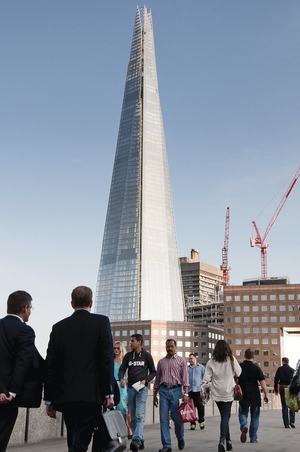

When the project team started plotting its construction strategy for The Shard, no one in the U.K. had ever planned a 306-meter-tall building or worked at such lofty heights. By the time the building opened in February, the members of the team had not only modernized the London skyline, they had departed in many ways from local and global high-rise construction traditions.
 |
Architect Renzo Piano named the tower during its planning by describing it as a shard of glass. Each facet of the facade is inclined to create the tapered tower. The steel-framed pinnacle is also clad by shards of glass.
The skyscraper is described by one judge as "a perfect design in the setting and an iconic structure that is a visual tour de force."
The 111,484-sq-m building contains office space on 25 floors, three restaurant levels, a 17-story hotel, 13 apartment floors and a triple-ceiling-height viewing gallery on level 72.
The team's innovations are several. One world first was a top-down approach to construction of the concrete core, which runs from basement level three (B3) to the 72nd floor. The top-down core work allowed crews to build the core's initial 23 stories and much of the surrounding tower before the basement levels were fully excavated.
The strategy involved supporting the core on temporary steel plunge columns, from level B2, while 23 floors of core were slipformed. Later, the lowest basement level was excavated underneath, the B3 raft slab was placed and then the bottom lift of the concrete core walls constructed. The novel technique sliced four months off the schedule, says the team.
Another world first was the use of an inclined exterior hoist, custom-made for the project, so that the hoist could closely follow the six-degree incline of the taper. A vertical hoist, at its top, would have been 25 m from the building.
The team also was the first to support a crane on top of a slipform. "The speed of construction meant that the traditional method of installing a crane mast within the core presented unacceptable risks. The solution was to run the core's slipform 24/7, thus eliminating delays," says the team.
Workers cast 5,500 cu m of concrete in 32 hours, taking into account 26 mixes, for the main pile cap and third basement slab. That was a record-size placement for the U.K.
More than 90% of the building's mechanical-electrical-plumbing systems were either prefabricated or assembled off site. The team used 3D modeling to help plan efficient installation. The approach reduced the number of MEP workers on site to no more than 200. That is an unprecedented number for a project of The Shard's size and complexity, says the team.
The Shard may be the tallest tower in Europe, but it is only four meters taller than the previous record-holder—Capital City Moscow Tower. And The Shard ranks only 58 on the Council on Tall Buildings and Urban Habitat's list of the 100 tallest buildings. Though dwarfed by many supertowers elsewhere, The Shard is still a real stand-out in London.
Location London
Project Team
Owner Sellar Property Group on behalf of LBQ, London
Design Architect Renzo Piano Building Workshop, Paris
General Contractor Mace, London
Project Manager Turner & Townsend, London
Structural Engineer WSP Group, London
Mechanical-Electrical-Plumbing Engineer Ove Arup and Partners, London
Executive Architect Adamson Associates, Toronto



Post a comment to this article
Report Abusive Comment